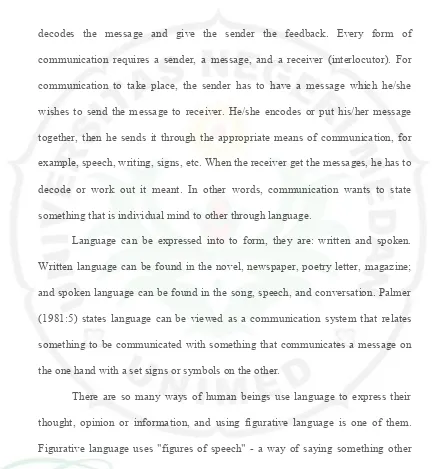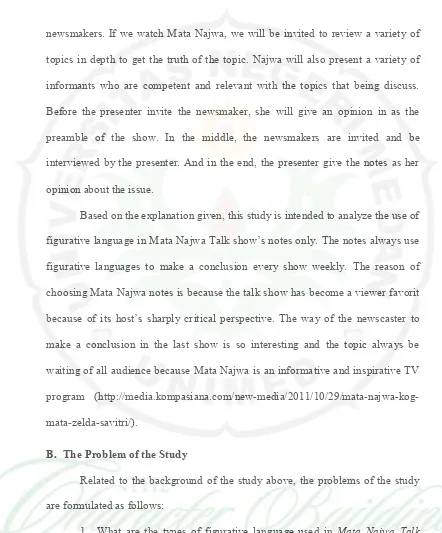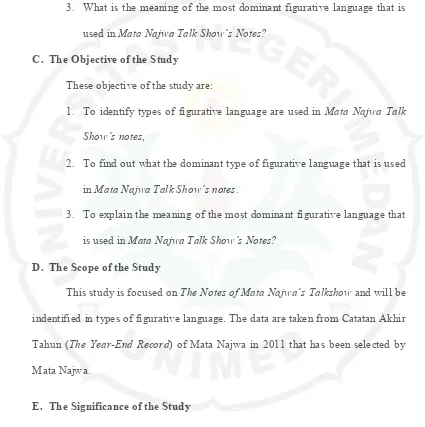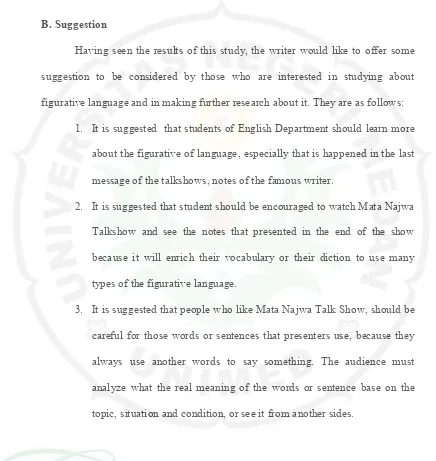THE FIGURATIVE LANGUAGE IN MATA NAJWA
TALK SHOW’S NOTES
A THESIS
Submitted in Partial Fulfillment of the Requirement for the Degree of Sarjana Sastra
By
RUTH STEVY HUTAJULU
Registration Number: 208222056
ENGLISH DEPARTMENT
FACULTY OF LANGUAGES AND ARTS
STATE UNIVERSITY OF MEDAN
DECLARATION
Except where appropriately acknowledge, this thesis is my own work, has
been expressed in my own words and has not previously been submitted for
assessment.
I understand that this paper may be screened electronically or otherwise
for plagiarism.
Medan, September 2012
i ABSTRACT
Hutajulu, Ruth Stevy 2012. Figurative language in Mata Najwa Talk Show’s notes. A Thesis. English and Literature Department. Faculty of Languages and Arts. State University of Medan.
ii
ACKNOWLEDGEMENTS
First of all, the writer would like to thank Jesus, for all His blessings and always give strength to the writer. Big thank is also given to all the people that has helped the writer during the completion of this thesis as the partial fulfillment of the requirements for Sarjana Sastra at English Department of Faculty of Arts and Languages, State University of Medan.
Due to the limited knowledge and experiences, the writer has been helped by many people, therefore in this occasion she would give her special thanks to:
1) Prof. Dr. Ibnu Hajar Damanik, M.Si., the Head of State University of Medan.
2) Dr. Isda Pramuniati, M. Hum., the Dean of Faculty of Languages and Arts, State University of Medan.
3) Prof. Dr. Hj. Sumarsih, M. Pd and Dra. Rahmah, M. Hum., both as the Head and The Secretary of English Department. Dra. Meisuri, M. A. As the Head of Applied Linguistics.
4) Drs. Muhammad Natsir, M. Hum., her thesis consultant for his advices, guidance, suggestions and all the time in finishing this thesis and also to
Dra. Setianna Simorangkir, M. A., her academic consultant.
5) For all the lecturers throughout her academic years at State University of Medan who have shared their knowledge.
6) H.T.P. Hutajulu and R. Sidabutar, her beloved parents who have given moral, spiritual, financial support, big endless love and pray.
7) Her brothers and sisters, T.M.V. Basten Hutajulu, F. Rogate Hutajulu,
Yuni Sarah Hutajulu, Dageng nami, Firma Devalima Hutajulu (+) and
Erbin Sinaga,
8) Her lovely friends during completing this thesis, Marojahan Sigiro, Erick Silalahi, Henny Sitohang, Ezra Hutahaean, Fiesta Sitorus, Kak Nana
Maman Simare-mare, Christian Manurung, Werdi Damanik, Haryanto Siregar, Faber Marpaung, Pranata Sihaloho, and all her friends that can not be mentioned one by one .
9) Her nice and beloved juniors, Handrian, Harna, Hanna, Hasian, Fariz,
Lisa, Sefti, Teguh, Hasian, Echa Decy, Indah, Kevin, Harnoi, Abie, Sofa
and all her dear brothers and sisters from 2009 to 2012 that also can not be mentioned one by one.
The writer admits that this thesis is far from being perfect. Therefore, she hope that this thesis still can be usefull for the readers. Finally, may God bless us and always do the best.
Medan, September 2012 The Writer,
iii
iii
CHAPTER II: REVIEW OF LITERATURE...7
A. Theoretical Framework...7
A. Figurative Language...7
a. The Types of Figurative language...8
1) Simile...9
b. Factors of using figurative language...15
B. Metro TV...15
a. Programs on Metro TV...18
b. Mata Najwa Talk Show...19
c. The Biography of Najwa Shihab...20
B. Conceptual Framework...21
CHAPTER III: METHODOLOGY OF RESEARCH...23
A. Research Design...23
B. Population and Sample ...23
C. Technique of Collecting Data ...24
D. Technique of Analyzing Data ...25
CHAPTER IV: THE DATA AND THE DATA ANALYSIS...26
A. The Data...26
iv
1. Simile...26
2. Metaphor...27
3. Symbol...28
4. Metonymy...28
5. Synecdoche...29
6. Personification...29
7. Hyperbole...30
8. Apostrophe...31
9. Allegory...32
10. Paradox ...33
11. Understatement...33
12. Irony...34
C. Research Findings...37
CHAPTER V: CONCLUSIONS AND SUGGESTIONS...40
A. Conclusions...40
B. Suggestions...41
v
LIST OF TABLE
Table Page
vi
LIST OF APPENDICES
APPENDIX Page
1
1
CHAPTER 1 INTRODUCTION
A. The Background of the Study
Language stands at the center of human affairs and was built up toward the
quality and the usage of it as the tool of communication. Language plays the role
as the main tool human to express thought, dreams, prayers, and experience (Clark
and Clark: 1977). The use of language has become deeply entrenched in human
culture and, apart from being used to communicate and share information.
Tarigan (1990:2) writes that the use of language as a means of
communication, both in oral and written form. Varies according to the knowledge
of language competence owned by the users. Language may refer either to the
spesifically human capacity for acquiring and using complex system of
communication, or to specific instance of such a system of complex
communication. When people use language as the tool of communication, we are
transferring information from on entity to another
(http://en.wikipedia.org/wiki/Communication#). Communication is done between
at least two agents (speaker and hearer). Communication is not only imparting or
interchanging of thought, opinions, or information by speech, writing, or signs,
but also exchanging and progressing of thoughts, feelings, or ideas (energy)
towards a mutually accepted goal or direction (information).
The process of communication in sending information to the interlocuter
(speaker/hearer) is enclosing it in a package, chanelling and imparting it by a
sender to a receiver via some mediums, and then the receiver (interlocutor)
2
example, speech, writing, signs, etc. When the receiver get the messages, he has to
decode or work out it meant. In other words, communication wants to state
something that is individual mind to other through language.
Language can be expressed into to form, they are: written and spoken.
Written language can be found in the novel, newspaper, poetry letter, magazine;
and spoken language can be found in the song, speech, and conversation. Palmer
(1981:5) states language can be viewed as a communication system that relates
something to be communicated with something that communicates a message on
the one hand with a set signs or symbols on the other.
There are so many ways of human beings use language to express their
thought, opinion or information, and using figurative language is one of them.
Figurative language uses "figures of speech" - a way of saying something other
than the literal meaning of the words. Figurative language is one of literary
aspects. It is a mode of expression which used in order to add beauty or emotional
intensity of something.
As we know, a word has two meaning: Literal meaning and figurative
meaning. Literal meaning means corresponding exactly to the original. Figurative
3
3
unfamiliar word in which most words have several meaning. Figurative meaning
use figure of speech too. Both of these always be used by people to say what they
want to say. But, because the figurative meaning shows the beauty of the
language, some of writer, poet, motivator, etc, always use the figurative language
to express their thinking and their feeling into a language.
Often, we encounter, there are so many poems, lyrics, quotes and also
notes that using more than two figurative language. There is no rule that say we
can not use more than one figurative language on one sentence. Just, if the writer
use more than one figurative language in one sentence, it means that he/she is a
creative person, because he/she can put more than one figurative language with a
beautiful words. Using figurative language makes the sentence is more interesting.
Talk show is a television (TV) or radio programmed in which people,
especially distinguished people, are invited to talk in an informal way about
various topics (http://en.wikipedia.org/wiki/Talk_show). Sometimes, talk shows
feature a panel of guests, usually consisting of a group of people who are learned
or who have great experience in relation to whatever issue is being discussed on
the show for that episode. Other times, a single guest discusses their work or area
or expertise with a host or co-host. A call-in show takes live phone calls from
callers listening at home, in their cars, etc. Sometimes, guests are already seated
but are often introduced and enter from backstage.
Mata Najwa (Through Najwa’s eyes) is a talkshow that presented by
Najwa Shihab and aired by Metro TV. Mata Najwa, an influential talk-show that
4
4
newsmakers. If we watch Mata Najwa, we will be invited to review a variety of
topics in depth to get the truth of the topic. Najwa will also present a variety of
informants who are competent and relevant with the topics that being discuss.
Before the presenter invite the newsmaker, she will give an opinion in as the
preamble of the show. In the middle, the newsmakers are invited and be
interviewed by the presenter. And in the end, the presenter give the notes as her
opinion about the issue.
Based on the explanation given, this study is intended to analyze the use of
figurative language in Mata Najwa Talk show’s notes only. The notes always use
figurative languages to make a conclusion every show weekly. The reason of
choosing Mata Najwa notes is because the talk show has become a viewer favorit
because of its host’s sharply critical perspective. The way of the newscaster to
make a conclusion in the last show is so interesting and the topic always be
waiting of all audience because Mata Najwa is an informative and inspirative TV
program
(http://media.kompasiana.com/new-media/2011/10/29/mata-najwa-kog-mata-zelda-savitri/).
B. The Problem of the Study
Related to the background of the study above, the problems of the study
are formulated as follows:
1. What are the types of figurative language used in Mata Najwa Talk
Show’s Notes?
5
5
3. What is the meaning of the most dominant figurative language that is
used in Mata Najwa Talk Show’s Notes?
C. The Objective of the Study
These objective of the study are:
1. To identify types of figurative language are used in Mata Najwa Talk
Show’s notes,
2. To find out what the dominant type of figurative language that is used
in Mata Najwa Talk Show’snotes.
3. To explain the meaning of the most dominant figurative language that
is used in Mata Najwa Talk Show’s Notes?
D. The Scope of the Study
This study is focused on The Notes of Mata Najwa’s Talkshow and will be
indentified in types of figurative language. The data are taken from Catatan Akhir
Tahun (The Year-End Record) of Mata Najwa in 2011 that has been selected by
Mata Najwa.
E. The Significance of the Study
Figurative language is a form of expression used to convey meaning or
heighten effect often by comparing or identifying one thing with another that has a
meaning or connotation familiar to the audience/reader/listener an involves
imagination. Thus, a researcher should have good intensity of imagination and try
6
6
It is expected that this work would be useful for:
1. Those who are interested to study figurative language in comunication
2. Those who are interested to study figurative language in talk show
3. To avoid the misconception in understanding figurative language in
Mata Najwa Talkshow’s notes
4. Readers who want to enrich their research about the figurative
language
5. Students to construct their knowledge or experience in figurative
40
CHAPTER V
CONCLUSION AND SUGGESTIONS
A. Conclusions
Having analyzed the use of figurative language in Mata Najwa Talkshow’s
notes, namely The Year-End Record during 2011, the conclusions of this research
are:
1. There are 11 types of figurative language that were used in The Year- End
Record of Mata Najwa Talkshow during 2011. They are, Simile,
Metaphor, Metonymy, Synecdoche, Personification, Hyperbole,
Apostrophe, Allegory, Paradox, Understatement and Irony.
2. The dominant type of figurative language that used in The Year-End
Record of Mata Najwa Talkshow during 2011 was Irony. Where the data
showed that irony was the dominant type, it leads us to make a mindset
that Irony always uses nearlyss in all of Mata Najwa Talk Show’s notes.
3. By using Irony in the notes, it means that most of notes of Najwa Shihab
on Mata Najwa Talk Show contains about insinuation to an object or
circumstances. Najwa Shihab tried to criticize something with a satirical
manner to say the opposite meaning. She use irony to ridicule or mock
someone, system or something in Indonesia.
41
B. Suggestion
Having seen the results of this study, the writer would like to offer some
suggestion to be considered by those who are interested in studying about
figurative language and in making further research about it. They are as follows:
1. It is suggested that students of English Department should learn more
about the figurative of language, especially that is happened in the last
message of the talkshows, notes of the famous writer.
2. It is suggested that student should be encouraged to watch Mata Najwa
Talkshow and see the notes that presented in the end of the show
because it will enrich their vocabulary or their diction to use many
types of the figurative language.
3. It is suggested that people who like Mata Najwa Talk Show, should be
careful for those words or sentences that presenters use, because they
always use another words to say something. The audience must
analyze what the real meaning of the words or sentence base on the
42
REFERENCES
Arikunto, Suharsimi. 2006. Prosedur Penelitian: Suatu Pendekatan Praktek.
Jakarta: Rineka Cipta.
Holman, C.H. and Harmon, W. 1986. A handbook to Literature. Washington, DC:
Macmillan.
Kennedy, J, X. 1983. Literature: An Introduction to Fiction, Poetry, and Drama.
Boston-Toronto; Little Brown and Company.
Leech, G. 1981. Semantic: The Study of Meaning. London: Penguins Books.
Loongman. 1982. Loongman Dictionary of English language. London: Longman House.
Maclin, Alice. 1992. A Handbook of English as a Second Language. Washington,
D.C. CBS College Publishing.
Napitupulu, R. 2003. Understanding Poetry. Medan: (Unpublished).
Nazir, M. 1988. Metode Penelitian. Jakarta: Ghalia Indonesia.
Nikelas. 1988. The Meaning of The Meaning. London: Routlede and Keagun Paul.
Saragih, Amrin. 2004. Metafora Tata Bahasa. Medan: Pascasarjana Unimed.
http://en.wikipedia.org/wiki/Communication#. accessed on December 8, 2011.
http://en.wikipedia.org/wiki/MetroTV. accessed on January 15, 2012.
http://najwashihab.com/. Accessed on January 15, 2012.
http://www.metrotvnews.com/read/newsprogramindex/1. Accessed on January 20,
2012
http: www.criticalreading.com/inference_figurative_language.htm. Accessed on
43
http://en.wikipedia.org/wiki/Talk_show. Accessed on March 29, 2012 http://metrotvnews.com/read/newsprograms/2011/12/29/11060/308/Catatan-Akhir-Tahun. Accessed on May 25, 2012



